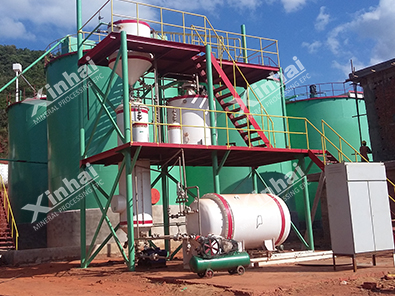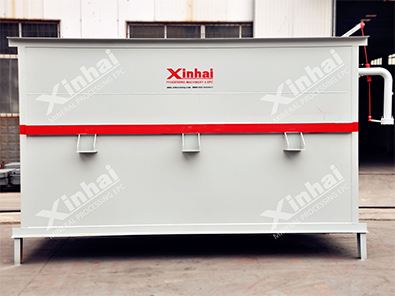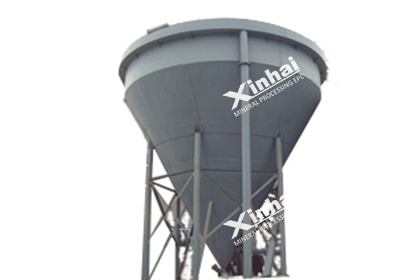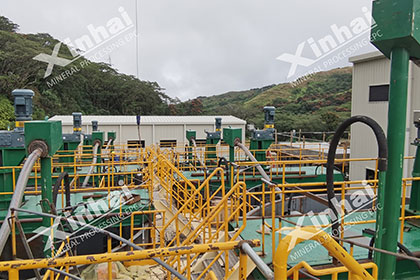A Comprehensive Guide to the Gold Leaching Process
 Essow
Essow
 Apr 25, 2024
Apr 25, 2024
 5840
5840
If you want to know more details about equipment, solutions, etc, please click the button below for free consultation, or leave your requirements!
Gold leaching is a fundamental process in the extraction of gold from ores. It involves dissolving gold from its ore using a chemical solution, commonly known as a leach reagent. The gold leaching process has been extensively studied and refined over the years to improve efficiency and minimize environmental impact. This article provides a comprehensive guide to the gold leaching process, exploring the various methods and factors that influence its success.
01 Understanding the Gold Leaching Process
BackGold leaching involves the dissolution of gold particles into a liquid medium, typically a cyanide or alternative lixiviant solution. The process aims to extract gold from low-grade ores or refractory ores that are not easily processed through conventional methods such as gravity separation or direct smelting. The leaching process can be carried out through various methods, including heap leaching, vat leaching, and agitated leaching.
The gold leaching process is a crucial step in the extraction of gold from ores. It involves dissolving gold particles from ore into a liquid medium, typically using a chemical solution known as a leach reagent. This process is employed for low-grade or refractory ores that cannot be efficiently processed through conventional methods like gravity separation or direct smelting.
Understanding the gold leaching process requires a comprehensive knowledge of factors that influence its success. Ore characteristics, including gold particle size and mineralogy, play a significant role in determining leachability. The selection of a suitable leach reagent, such as cyanide or alternative lixiviants, is essential for effective gold dissolution.
Optimizing the process involves careful control of parameters like leach solution pH, temperature, agitation, and reagent concentrations. Advanced analytical techniques and automated control systems enable real-time monitoring and adjustments to maintain optimal conditions.
The gold leaching process continues to evolve, with ongoing research focused on developing alternative lixiviants and exploring bioleaching approaches. By improving process optimization, control, and environmental considerations, the industry aims to maximize gold recovery while minimizing environmental impact, ensuring the significance of gold leaching in the global mining sector.
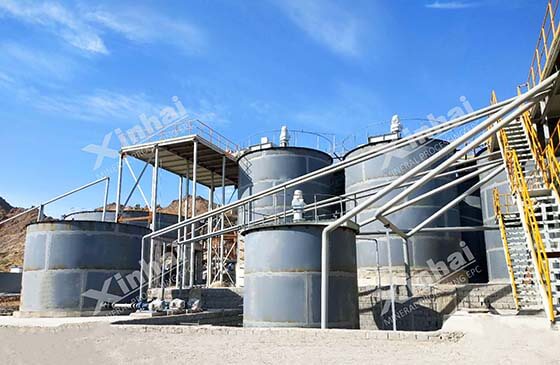
(Gold Leaching Tanks)
02 Factors Affecting Gold Leaching
BackSeveral factors influence the efficiency and effectiveness of the gold leaching process. These include the ore characteristics (such as gold particle size and mineralogy), leach reagent selection, leach solution pH, temperature, and agitation. Understanding these factors is crucial for optimizing the leaching process and maximizing gold recovery. Additionally, the presence of impurities and other minerals in the ore can impact the leaching process and require specific treatment strategies.
The gold leaching process is a complex series of chemical reactions that facilitate the dissolution of gold particles from ore into a liquid medium. It is crucial to have a clear understanding of the process to optimize gold recovery and ensure effective extraction. Here are some key aspects to consider:
1. Ore Characteristics
The characteristics of the gold-bearing ore play a significant role in determining the leaching process's success. Factors such as gold particle size, mineralogy (presence of other minerals), and ore composition affect the leaching kinetics and overall efficiency. Fine-grained gold particles are generally more amenable to leaching, whereas coarse gold particles may require additional grinding or pre-treatment steps to enhance leachability.
2. Leach Reagent Selection
The choice of leach reagent depends on various factors, including ore type, gold mineralogy, and environmental considerations. Cyanide is the most commonly used leach reagent due to its high effectiveness in dissolving gold. However, the toxicity and environmental concerns associated with cyanide have led to the exploration of alternative lixiviants, such as thiosulfate, bromide, and chloride-based solutions. Each reagent has its own advantages and limitations, and their selection depends on specific project requirements.
3. Leach Solution pH
The pH of the leach solution is a critical parameter that influences the gold leaching process. Generally, alkaline conditions (pH above 9) are preferred for cyanide-based leaching, as they enhance the stability and reactivity of the gold-cyanide complex. In contrast, alternative lixiviants may operate under different pH ranges. Maintaining the appropriate pH level ensures optimal gold dissolution and minimizes unwanted side reactions.
4. Temperature
Temperature significantly affects the rate of gold leaching. Higher temperatures generally accelerate the leaching process by increasing the reaction kinetics. However, elevated temperatures may also promote the volatilization of certain reagents, alter the stability of the gold-cyanide complex, or affect the solubility of other minerals present in the ore. Careful control of temperature is essential to strike a balance between enhanced leaching efficiency and potential adverse effects.
5. Agitation
Agitation is commonly employed during gold leaching to enhance mass transfer and improve contact between the ore and leach solution. Agitation methods include mechanical stirring, air sparging, or using specialized equipment like agitators or reactors. Proper agitation ensures a homogeneous distribution of the leach reagent, prevents the accumulation of precipitates, and facilitates efficient gold dissolution.
03 Common Gold Leaching Techniques
Back1. Cyanide Leaching
Cyanide leaching is the most widely used method for gold extraction. It involves the use of a dilute cyanide solution that reacts with gold to form a soluble complex. This method is effective for most types of gold ores but requires careful management to prevent environmental contamination.
2. Alternative Lixiviants
In recent years, there has been growing interest in developing alternative lixiviants to replace or reduce the use of cyanide. These include thiosulfate, bromide, and chloride-based solutions. Alternative lixiviants offer potential advantages such as lower toxicity and improved selectivity. However, further research is needed to optimize these methods and make them commercially viable.
3. Biological Leaching
Bioleaching, or biomining, utilizes microorganisms to facilitate the leaching process. Certain bacteria and fungi can oxidize sulfide minerals and solubilize gold, making it accessible for extraction. Bioleaching is an environmentally friendly approach that can be applied to refractory gold ores with complex mineralogy.
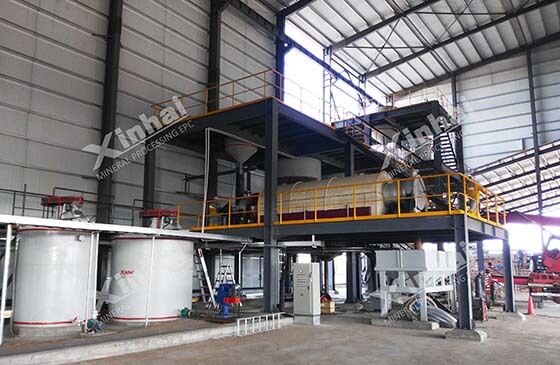
(Desorption Electrolysis System)
04 Process Optimization and Control
BackEfficient gold leaching requires careful process optimization and control. Monitoring key parameters such as leach solution pH, temperature, oxygen levels, and reagent concentrations is essential. Advanced analytical techniques, such as online analyzers and automated control systems, can help maintain optimal conditions and improve process efficiency. Additionally, modeling and simulation tools can aid in predicting and optimizing the leaching process for specific ore types.
Process optimization and control are critical aspects of the gold leaching process to ensure efficient operation, maximize gold recovery, and minimize costs. Here are some key considerations for optimizing and controlling the gold leaching process:
1. Monitoring Key Parameters
Monitoring and controlling key parameters during the leaching process are essential for maintaining optimal conditions. Parameters such as leach solution pH, temperature, oxygen levels, and reagent concentrations need to be continuously monitored. Real-time data acquisition through sensors and analyzers provides valuable insights into process performance and enables timely adjustments.
2. Advanced Analytical Techniques
Advanced analytical techniques are employed to monitor and analyze the composition of the leach solution and the concentrations of key species, including gold, reagents, and impurities. Online analyzers, such as atomic absorption spectroscopy (AAS) or inductively coupled plasma optical emission spectroscopy (ICP-OES), offer real-time monitoring capabilities, allowing for instant feedback and control adjustments.
3. Automated Control Systems
Automation plays a vital role in optimizing the gold leaching process. Automated control systems use real-time data to make instantaneous adjustments to the process parameters, ensuring consistent and efficient operation. These systems can regulate variables such as reagent dosages, pH, temperature, and agitation rates based on predefined setpoints or dynamic optimization algorithms.
4. Modeling and Simulation
Mathematical modeling and simulation tools are valuable for predicting and optimizing the gold leaching process. These models consider factors such as ore characteristics, reagent kinetics, and mass transfer rates to simulate the behavior of the leaching system. By using these models, engineers can assess the impact of different process variables, optimize reagent dosages, and predict gold recovery rates for specific ore types.
5. Feedback and Process Improvement
Continuous feedback and process improvement are crucial for optimizing the gold leaching process over time. Regular analysis of performance indicators such as gold extraction efficiency, reagent consumption, and operating costs allows for the identification of areas for improvement. This feedback loop facilitates process adjustments, optimization of operating conditions, and implementation of innovative techniques to enhance overall process performance.
6. Environmental Considerations
Process optimization and control should not overlook environmental considerations. Efforts should be made to minimize the environmental impact of the gold leaching process, including proper containment of reagents, waste management, and tailings disposal. By implementing eco-friendly practices, such as reagent recycling, water treatment, and utilizing renewable energy sources, the environmental footprint of the gold leaching process can be reduced.
05Conclusion
BackThe gold leaching process is a vital step in gold extraction, enabling the recovery of gold from low-grade or refractory ores. Understanding the factors influencing the process and employing appropriate leaching techniques are key to maximizing gold recovery and minimizing environmental impact. Continuous research and innovation in gold leaching methods, including the development of alternative lixiviants and bioleaching approaches, are driving the industry toward more sustainable and efficient practices. As technology advances, further improvements in process optimization, control, and environmental considerations will likely enhance the gold leaching process, ensuring its continued significance in the global gold mining industry.
 +86 183 3575 8886
+86 183 3575 8886 pinklaurabao@gmail.com
pinklaurabao@gmail.com




 Message
Message Chat Now
Chat Now



